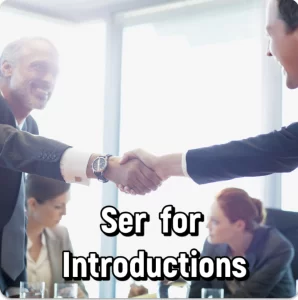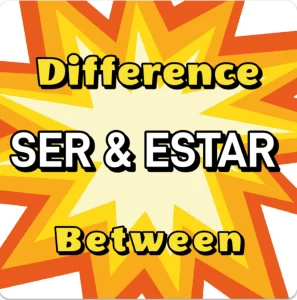
Ser Verb Conjugations
Time and Events
“Ser” is also used to indicate time and to describe events. When telling time, “ser” becomes an essential part of the conversation:
- Son las dos.
- Es la una.
- Son las 4pm.
For events, “ser” helps to set the stage and define when and where things happen:
- La reunión es a las tres.
- La fiesta es en mi casa.
- La clase de español es a las 6pm
One of the Top Ten Spanish Verbs to Learn
Given its wide range of uses and its fundamental role in everyday communication, “ser” is undoubtedly one of the top ten Spanish verbs that Spanish students must master. It might seem like the ser verb is used for so many different reasons. The most important function of the ser verb is for introducing people & giving descriptive intel about a subject. Make sure you practice that! Don’t worry about the other limited functions!
When do you use Ser or Estar?
Ser and Estar mean the same thing in English so students get confused. The easiest way to set them apart is the Ser verb focuses on the WHO and estar focuses on the WHERE! This is a great way to know when do you use Ser or Estar! Think of estar as the gps verb! 🙂 Read more about the differences between Ser & Estar in this other blog post!
Ser Verb Conjugations Practice Ideas:
- Take out a family photo and introduce everyone in the pic using Ser!
- Practice introducing yourself ( and partner/family)
- Practice introducing your favorite characters on tv.
- Do Ser verb conjugation practice worksheets!
- Practice talking to yourself out loud!
- Use your voice recorder and listen to yourself!
Additional Tips For Ser & Spanish language learning:
You MUST do 4 things with any Spanish language material you are trying to learn! You must:
- Learn the Material & Understand it
- Do written work- homework/assignments
- Do conversational Spanish drills with the material you learned
- Do auditory comp. exercises with the material
These four stages must be done in order to move on to new material. If you don’t, you will most probably stay stuck and never feel as comfortable or confident as you want to be! If you go to the gym and do bicep curls, you will only get strong biceps and not strong legs muscles or abdominal muscles.
Same thing happens with foreign language learning! You only practice reading or writing Spanish then that is all you will be good at! You must SPEAK to friends, classmates or to yourself, if you don’t have people to practice with! Make sure you practice your conjugations of ser verb in Spanish in multiple ways! Your brain is powerful and you are capable! Are you willing to be patient and do the work? 🙂 Buena suerte amigos!

Want to learn Spanish with Us?
Take one of our 6 week Spanish courses LIVE via zoom. We offer a free mini demo, assessment & placement! Talk to our professional Spanish instructor and get the answers you need before signing up! We are one of the best Spanish language studios in the USA. We use unique and original teaching methodologies to help students learn Spanish organically. Our Spanish language instruction works for almost every learning style! Find out yourself! Contact Spanish in Atlanta









12 Comments
I’m amazed at the clarity you bring to complex subjects. Ser verb conjugations and usage has never been completely clear to me until now. I also struggled with when to use ser and when to use estar. Will you be offering free estar verb worksheets too?
Hola Adalberto, Muchas gracias! We created this Spanish blog to help students so we are happy to know that is what we are doing 🙂 We will create more free content. We ask that you all support us by commenting and sharing. This helps Spanish in Atlanta make the time needed to create more free Spanish worksheets and content.
We do have a blog post that talks about when to use Ser and Estar just CLICK HERE
This is very helpful! Gracias maestra. Can you do the imperfect tense? I can’t figure it out and I think you would be the one to help me. I love how you explain things.
Si claro! The imperfect Spanish tense is another killer lol but it is doable as long as you use a good strategy! Spanish in Atlanta has created an easy approach to Past tense Spanish and the imperfect tense. Preterite versus the Spanish imperfect tense– just click this link to read more about it.
I have never found a good explanation of ser & estar verbs. I finally feel like I get it. The worksheets were excellent. I realized I didn’t really have this memorized that well.
Muchas gracias por tus comentarios Greg! 🙂
I’ve been learning Spanish for a while now, and one thing that still frustrates me is knowing when to use ser versus estar. I understand that ser is for more permanent things and estar is for temporary conditions, but in practice, it’s so tricky! I always second-guess myself when I’m forming sentences. For example, should I say “soy feliz” or “estoy feliz”? I know there are some rules, but it feels like it changes depending on the situation. Do you have any tips to help make this distinction easier?
I recently came across the verb form “sois” in the conjugation for ser. I’m a bit confused about it. I know “soy,” “eres,” “es,” and “somos,” but I’m not sure when or where “sois” is actually used. Is it specific to a certain region or dialect? I haven’t seen it much in the materials I’ve been studying, but I know it’s part of the ser conjugation.
Any advice on how to get better at knowing when to use ser versus estar would be super helpful, and I’d love a clearer explanation of “sois” and when it’s used if possible. Thanks
Hola Ethan, Spanish ser verbs and Estar are one of the more challenging things to get right so don’t worry. Spanish in Atlanta has a blog post that discuses the differences between ser and Estar verbs Click on this link to read our post on these Spanish verbs.
Think of Ser as the WHO verb and Estar verb as the WHERE verb. It is a simplistic answer for now but a powerful one! Sois is just a conjugation of the Ser verb that belongs to the pronoun Vosotros. Vosotros is only really used in Spain so it’s not that important unless you plan to live/ travel to Spain.
Either way it’s easy to learn, if you end up in Spain. Most Spanish speaking countries use Ustedes and not vosotros. Buena suerte amigo! 🙂 Note: if you need professional help we offer it. We do live Spanish classes and tutoring via zoom. Contact us, if you want to inquire!
I’ve been learning Spanish for a while, and it’s been pretty easy so far, but *ser* and *estar* have me totally stuck! I can’t seem to get the hang of when to use each one. Is ser used more often than estar in everyday conversations? It feels like I keep mixing them up, and it’s the first time I’ve really struggled with something in Spanish. Are there other tricky areas like this that I should expect as I continue learning Spanish? I’d love to know what to watch out for as I keep practicing Spanish.
Hola! YES! hahahaha ( evil laugh) kidding!!! Ser and Estar Spanish verbs are one of the 4 most challenging things to learn in Spanish. My opinion the most challenging are:
-Spanish imperfect tense and preterite past tense
-Command form
– Subjunctive moods
– Dops and iops
Everything after that is pretty straigt forward as long as you invest some time and make an effort.
Quick question. does the Spanish verb ser ever get used by itself in a sentence, or is it always conjugated as soy, eres, es, somos, or son in the present tense? I’ve only seen it in its conjugated forms, but I’m wondering if there’s a situation where just *ser* would be used as is. I’m still learning and trying to figure out how it works in different contexts. Any help would be appreciated!
Que tal William! Yes the Ser verb in its infinitive form can be used in a Spanish sentence only when it’s the 2nd verb. In other words, if a sentence has 2 verbs back to back the second verb is where the infinitive can be used.
Examples:
Yo quiero ser famosa
ellos necesitan ser mas responsables
ella quiere ser una doctora
I hope this helps!